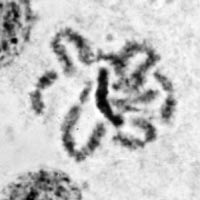

If a membrane has formed around the chromosomes at the end of the first division, it disappears during prophase II. During prophase II, the individual chromosomes of the daughter cells become distinct again and begin to prepare for the second meiotic division. At the beginning of prophase II of meiosis, which occurs after telophase during the first meiotic division, the chromosomes of each daughter cell are grouped together in a mass. The synaptonemal complex starts building up. Zygotene- In this phase the homologous chromosomes start pairing up, called the synapsis. It is marked by the condensation of the chromosomes. Leptotene- This phase is the start of prophase-I. In mitosis, by contrast, pairs of homologous chromosomes remain separate and there is no crossing over, since the purpose of mitosis is to produce cells with identical genetic material rather than gametes. The prophase I of meiosis occurs in the following stages: 1. For recombination, meiosis requires that homologous chromosomes are properly paired and aligned by the induction of DNA double-strand breaks by the enzyme SPO11 during the prophase of. This process creates genetic diversity among the gametes formed through meiosis. Meiosis is the special type of recombinative and reductive cell division occurring only in the generation of the gametes or germ cells (oocyte and spermatozoa). In prophase I of meiosis, pairs of homologous chromosomes intertwine and the process called crossing over occurs as chromatids from homologous pairs of chromosomes swap genetic information. The prophase of meiosis occurring during the first meiotic division of the cell is usually called prophase I. However, there are important distinctions between prophase of mitosis and prophase of meiosis. Specifically, MEIOC, together with YTHDC2, promotes a meiotic (as opposed to mitotic) cell cycle program via post-transcriptional control of their target transcripts.One of the two stages in meiosis that resemble prophase in mitosis. We conclude that when the meiotic chromosomal program is initiated, Meioc is simultaneously induced so as to extend meiotic prophase.

MEIOC interacts with YTHDC2, and the two proteins pull-down an overlapping set of mitosis-associated transcripts. Meioc-deficient spermatocytes that have initiated synapsis mis-express CYCLIN A2, which is normally expressed in mitotic spermatogonia, suggesting a failure to properly transition to a meiotic cell cycle program. However, cells in early meiotic prophase-as early as the preleptotene stage-proceed to condense their chromosomes and assemble a spindle, as if having progressed to metaphase. Mouse germ cells lacking Meioc initiate meiosis: they undergo pre-meiotic DNA replication, they express proteins involved in synapsis and recombination, and a subset of cells progress as far as the zygotene stage of prophase I. In mice, Meioc is expressed in male and female germ cells upon initiation of and throughout meiotic prophase I. This single substep of Prophase is further subdivided into 5 stages, namely - Leptotene, Zygotene, Pachytene Diplotene, and Diakinesis.

The Prophase of Meiosis is quite long and more complex than the Prophase of Mitosis. Here we show that, in mice, maintenance of an extended meiotic prophase I requires the gene Meioc, a germ-cell specific factor conserved in most metazoans. Meiosis I - Prophase I : This is the first step in the process of Meiosis cell division. The meiosis-specific chromosomal events of homolog pairing, synapsis, and recombination occur over an extended meiotic prophase I that is many times longer than prophase of mitosis.


 0 kommentar(er)
0 kommentar(er)
